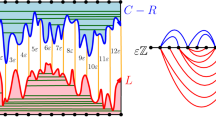Abstract
We define and study stochastic areas processes associated with Brownian motions on the complex symmetric spaces \(\mathbb {CP}^n\) and \(\mathbb {CH}^n\). The characteristic functions of those processes are computed and limit theorems are obtained. In the case \(n=1\), we also study windings of the Brownian motion on those spaces and compute the limit distributions. For \(\mathbb {CP}^n\) the geometry of the Hopf fibration plays a central role, whereas for \(\mathbb {CH}^n\) it is the anti-de Sitter fibration.
Similar content being viewed by others
Notes
We will call north pole the point with complex coordinates \(z_1=0,\ldots , z_{n+1}=1\).
We call 0 the point with inhomogeneous coordinates \(w_1=0,\ldots , w_{n}=0\).
For Berger [5].
References
Baudoin, F.: Stochastic Taylor expansions and heat kernels asymptotics. ESAIM Probab. Stat. 16, 453–478 (2012)
Baudoin, F., Bonnefont, M.: The subelliptic heat kernel on SU(2): representations, asymptotics and gradient bounds. Math. Zeit. 263(3), 647–672 (2009)
Baudoin, F., Wang, J.: The subelliptic heat kernel on the CR sphere. Math. Z. 275(1–2), 135–150 (2013)
Bérard-Bergery, L., Bourguignon, J.P.: Laplacians and Riemannian submersions with totally geodesic fibres. Ill. J. Math. 26(2), 181–200 (1982)
Berger, M.: Les variétés riemanniennes homogènes normales simplement connexes à courbure strictement positive. Ann. Scuola Norm. Sup. Pisa 15, 179–246 (1961)
Biane, P., Pitman, J., Yor, M.: Probability laws related to the Jacobi theta and Riemann zeta functions, and Brownian excursions. Bull. AMS 38(4), 435–465 (2001)
Bismut, J.M.: The Atiyah–Singer theorems. J. Funct. Anal. 57, 56–99, 329–348 (1984)
Bismut, J.M.: Formules de localisation et formules de Paul Lévy. Astérisque 157–158. Colloque Paul Lévy sur les processus stochastiques, pp. 37–58 (1988)
Bonnefont, M.: The subelliptic heat kernel on SL(2, R) and on its universal covering: integral representations and some functional inequalities. Potential Anal. 36(2), 275–300 (2012)
Demni, N., Zani, M.: Large deviations for statistics of the Jacobi process. Stoch. Process. Appl. 119(2), 518–533 (2009)
Duplantier, B.: Areas of planar Brownian curves. J. Phys. A Math. General 22(15), 3033–3048 (1989)
Friz, P., Victoir, N.: Multidimensional Dimensional Processes Seen as Rough Paths. Cambridge University Press, Cambridge (2010)
Gaveau, B.: Principe de moindre action, propagation de la chaleur et estimées sous elliptiques sur certains groupes nilpotents. Acta Math. 139(1–2), 95–153 (1977)
Jakubowski, J., Wisniewolski, M.: On hyperbolic Bessel processes and beyond. Bernoulli 19(5B), 2437–2454 (2013)
Lévy, P.: Le mouvement Brownien plan. Am. J. Math. 62, 487–550 (1940)
Li, X.M.: Limits of random differential equations on manifolds (2015). Probab. Theory Relat. Fields. arXiv:1501.04793
Li, X.M.: Stochastic homogenisation on homogeneous spaces (2015). arXiv:1505.06772
Pauwels, E.J., Rogers, L.C.G.: Skew-product decompositions of Brownian motions. Contemp. Math. 73, 237–262 (1988)
Revuz, D., Yor, M.: Continuous martingales and Brownian motion. 3rd edn. Grundlehren der Mathematischen Wissenschaften (Fundamental Principles of Mathematical Sciences), 293. Springer, Berlin (1999)
Warren, J., Yor, M. (1998) The Brownian burglar: conditioning Brownian motion by its local time process. Séminaire de Probabilités, XXXII, pp. 328–342. Lecture Notes in Math., 1686, Springer, Berlin (1998)
Wang, J.: The subelliptic heat kernel on the anti-de sitter space. Potential Anal (2016). doi:10.1007/s11118-016-9561-2
Watanabe, S.: Asymptotic windings of Brownian motion paths on Riemann surfaces. Acta Appl. Math. 63, 441–464 (2000)
Williams, D.: On a stopped Brownian motion formula of H.M. Taylor. Sem. Proba. X. (Lecture Notes in Mathematics, vol. 511) Springer, Berlin, pp. 235–239 (1976)
Yor, M.: Remarques sur une formule de Paul Lévy. Sém. Proba. XIV. (Lecture Notes in Mathematics, vol. 784) Springer, Berlin, pp. 343–346 (1980)
Yor, M.: Loi de l’indice du lacet Brownien, et distribution de Hartman–Watson. Probab. Theory Relat. Fields 53(1), 71–95 (1980)
Author information
Authors and Affiliations
Corresponding author
Additional information
Dedicated to Marc Yor.
Fabrice Baudoin: Author supported in part by Grant NSF-DMS 15-11-328.
Appendix: Jacobi diffusions
Appendix: Jacobi diffusions
We collect here some well-known facts about Jacobi diffusions (see for instance [10] and the references therein for further details). The Jacobi diffusion is the diffusion on \([0,\pi /2]\) with generator
defined up to the first time it hits the boundary \(\{ 0, \pi /2 \}\).
The point 0 is:
-
A regular point for \(-1<\alpha <0\);
-
An entrance point for \(\alpha \ge 0\).
Similarly, the point \(\pi /2\) is:
-
A regular point for \(-1<\beta <0\);
-
An entrance point for \(\beta \ge 0\).
If r is a Jacobi diffusion with generator \({\mathcal {L}}^{\alpha ,\beta }\), then it is easily seen that \(\rho =\cos 2r\) is a diffusion with generator \(2{\mathcal {G}}^{\alpha ,\beta }\) where,
The spectrum and eigenfunctions of \({\mathcal {G}}^{\alpha ,\beta }\) are known. Let us denote by \(P_m^{\alpha ,\beta }(x)\), \(m\in {\mathbb {Z}}_{\ge 0}\) the Jacobi polynomials given by
It is known that \(\{P_m^{\alpha ,\beta }(x)\}\) is orthonormal in \(L^2([-1,1], 2^{-\alpha -\beta -1}(1+x)^{\beta }(1-x)^{\alpha }dx)\) and satisfies
If we denote by \(p^{\alpha ,\beta }_t(x,y)\) transition density with respect to the Lebesgue measure of the diffusion \(\rho \) starting from \(x \in (-1,1)\), then we have
In particular, when 1 is an entrance point, that is \(\alpha \ge 0\), we obtain
By denoting \(q_t^{\alpha ,\beta }\) the transition density of r, we obtain then for \(\alpha ,\beta \ge 0\),
and
Rights and permissions
About this article
Cite this article
Baudoin, F., Wang, J. Stochastic areas, winding numbers and Hopf fibrations. Probab. Theory Relat. Fields 169, 977–1005 (2017). https://doi.org/10.1007/s00440-016-0745-x
Received:
Revised:
Published:
Issue Date:
DOI: https://doi.org/10.1007/s00440-016-0745-x



